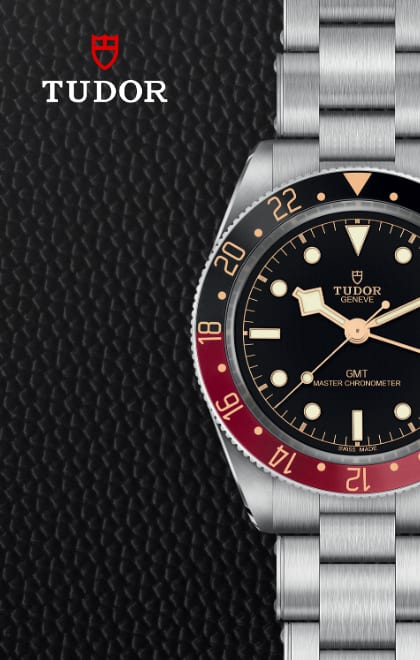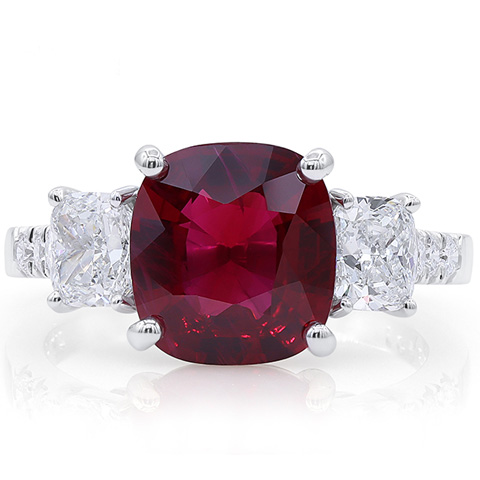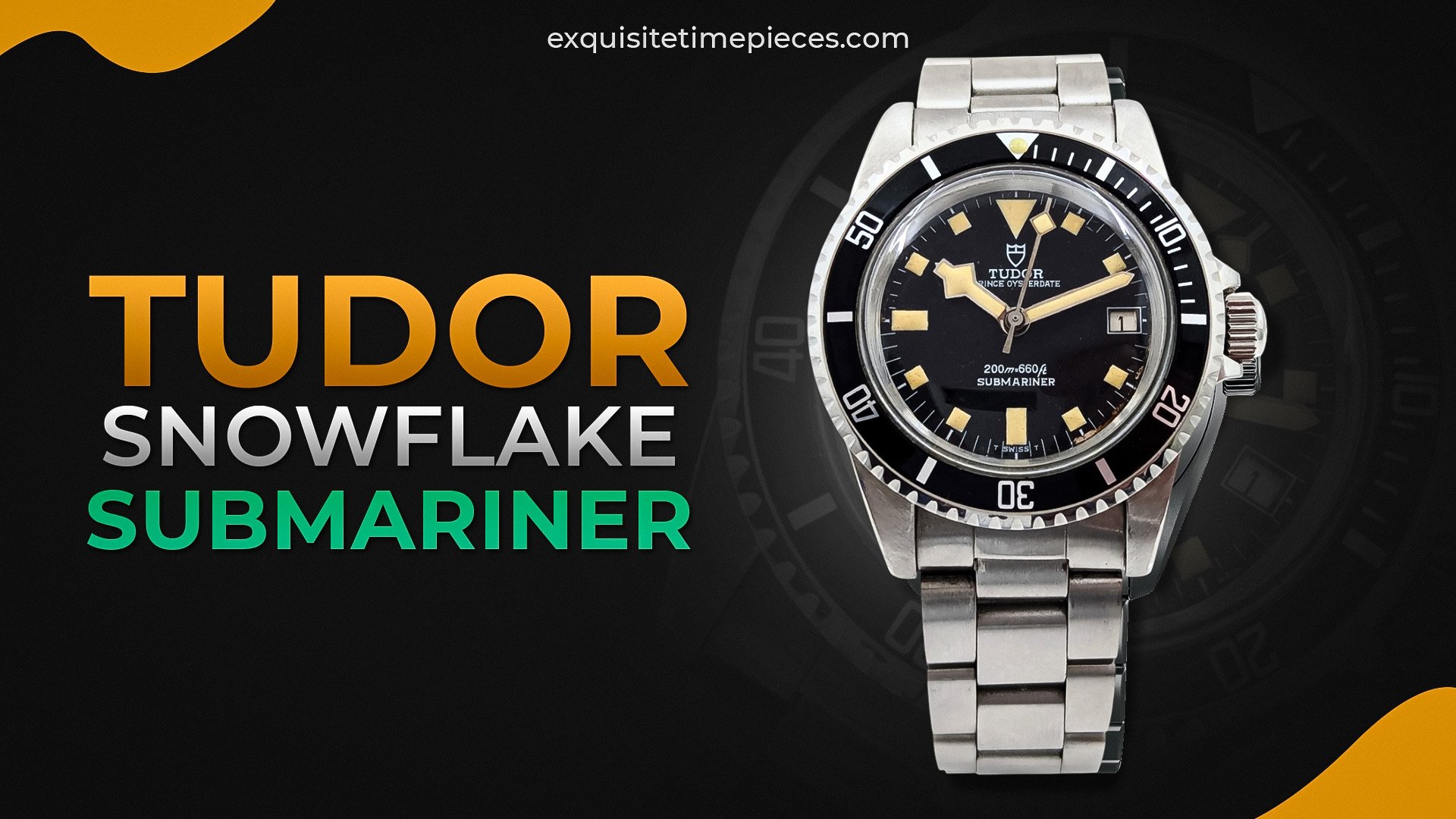
An In-Depth Guide to the ICONIC Tudor “Snowflake” Submariner
Tudor is famously heralded as the sister brand of Rolex; following its takeover in 1936 by Rolex founder Hans Wilsdorf, the brand would contribute to achieving economies of scale and target a price-conscious market segment. To achieve this, Tudor would use third-party movements; but would hugely benefit from the sharing of technology, technical, aesthetic, and functional characteristics under the same roof as its hugely successful counterpart.
Fundamental to Tudors dive watch history was the introduction of the Tudor Oyster in 1947. The “Oyster” nameplate was first seen on Rolex models in 1926 to denote its water resistance. It was the first truly waterproof case, one of the most important milestones in watchmaking history, and a precursor to the purpose-built dive watch that would be released in 1953.
The first Tudor dive watch would follow the footsteps of the legendary Rolex Submariner, released in 1953, with the release of the Tudor Oyster Prince Submariner reference 7922 a year later to be the more affordable Submariner. This would mark the initial era of its dive watch lineup inspired by the 6204 and 6205 Rolex Submariner, mirroring its aesthetics, most notably the dial layout of the 6205.
The second era of Tudor Submariners began in 1969, with the brand finding its own identity in aesthetics to make for an equally iconic dial layout to the “OG” Rolex Submariner, also developed for the explicit needs of diving. It would utilize square hour markers with matching hands and would be recognized by collectors as “Snowflakes”.
About the Tudor Submariner (the Predecessor to the Snowflake)
Ready to capitalize on the winning formula of the very first Rolex submariner, the first dive watch from Tudor, the Oyster Prince 7922, was released in 1954. It was intended to be a budget-focused counterpart of the exceptional Submariner released the previous year, mirroring its design aesthetics, features, and robust characteristics.
Like the Rolex Submariner, it utilized a 37mm Oyster-case with a screw-down case-back and crown to reach a guaranteed depth of 100 meters.
It took inspiration from the 1954 Submariner 6205 reference dial layout that rewrote the book on legibility with its usage of lumed triangular, circular, and rectangular plots for hour indexes, with a lumed Mercedes hour hand, pencil-shaped minute hand, and seconds hand with a straight tip after the lollipop on a contrasting domed black dial with gilt logo/inscriptions and minute track, viewable under domed plexiglass commonly used in this era.
To precisely measure dive times and adjust decompression stages, it came equipped with a bi-directional rotatable bezel graduated in 5-minute intervals and a lume-pip at zero. All Tudor Submariners would use reliable third-party movements to cut down on costs to the end consumer, and the 7922 would be equipped with the self-winding Calibre 390 with 18,000 beats per hour.
Common to all Tudor Submariners, it shared components with its sister brand, such as its Oyster-case, screw-down crown, and Oyster-style riveted bracelet, all signed with the Rolex logo. All iterations of the 7900 series would follow the trend of piggybacking off Rolex’s proven back catalog and would only house a Calibre 390 movement.
The 7923 in 1955 would be a brief departure from this path, as it was the only reference to feature a manually wound movement (ETA Calibre 1182). It also featured a less legible pencil hour hand instead of the Mercedes hand and two cylindrical bars replacing the curved links that attached the Oyster-style bracelet to its case.
In 1958 the 7924 appeared, following the path of the Rolex Submariner 6200 from 1955, reverting to the characteristic Submariner hands and bracelet and offering 200 meters of water resistance with the use of a larger 8mm “Big-crown”, a thicker Plexiglas, and a thicker case.
In 1959, the 7928 reference followed and would be the most diverse reference in Tudor’s lineup being in production for nearly 10 years. Major changes in this reference were the adoption of a larger case size from 37mm to 39mm and the introduction of crown guards influenced by the needs of the French Navy.
With the usage of a smaller 6mm crown, it first had square crown guards; pointed crown guards followed in 1961, and later a refined rounded shape that would be retained for future models. The 7298 also saw many dial variations, with the shift from gilt text to silver, and finally white text, the usage of a closed to an open chapter ring, and gilt hands to silver hands.
History & Origin of the Tudor “Snowflake”
The 7928 and its adoption of a more “Professional” crown guard equipped 39mm case developed in conjunction with the needs of the French Navy was hence supplied to the French Navy and the U.S Navy for its professional use.
This signaled the direction for the next generation of Submariners from Tudor, departing from the Rolex aesthetic that defined the 7900 series. A quote by Mark Twain, ”There is no such thing as a new idea. It is impossible. We simply take a lot of old ideas and put them into a sort of mental kaleidoscope”.
This could not be truer for the impact the characteristic Rolex Submariner aesthetic has had on the 7900 series Tudors and for any dive watch that would follow its huge success and legendary status. Under the roof of the Crown, with the motive to differentiate its second generation of Submariners, did Tudor execute a new idea?
In 1969, Tudor presented a new face for its Submariner, but was it better than the iconic one it replaced? It used square indexes reminiscent of the 70s approach to design instead of the symmetrical and attractive round indexes.
These Submariners would be nicknamed “Snowflakes” due to the form of their indexes. With less negative space on the dial and more surface area for luminescence, it proved to be more functional and utilitarian than the rounded indexes of before. As a result, Snowflakes have been hugely praised by collectors as potentially the cooler, more professional, and less mainstream alternative to its iconic sibling.
The Tudor “Snowflake” Submariner 7016 & 7021
Developed for the explicit needs of divers, known to be specifically designed with the feedback of the Marine Nationale (to be more legible in low light conditions), the majorly changed Snowflake Submariners, the 7016 and 7021, were released in 1969. With them began the second generation of Tudor Divers.
The 7016 and 7021 were the first Submariners from Rolex or Tudor to be offered in blue (in addition to the standard black), a highlight of this and the models to follow, as even today, the Rolex Submariner range does not offer a blue dial variant for its steel models. It also finally did away with the Calibre 390 movement for ETA movements, which would prove to be easier to service.
The 7016 was equipped with a 39mm case, a 60-minute bidirectional rotatable bezel, rounded crown guards, and 200m of water resistance, unchanged to that of its predecessor. Still features Rolex signed parts, such as its case, crown, and new Oyster Style non-riveted bracelet.
Its new Snowflake dial replaced the rose logo with a shield logo (a symbol of resistance and reliability) and featured square indexes that reciprocate with rectangular indexes at 15, 30, and 45, paired with a square on the hour hand and seconds hand (nicknamed “snowflake hands”). Visible under a no longer domed but flat Plexiglass crystal.
With the new reference followed a new caliber, the ETA 2483, with a frequency of 18,000 beats per hour, the same as the one it replaced. From the learnings of the Rolex Submariner Date 1680 arrived a date variation of the Snowflake, the 7021. It shared the exact specifications with its no-date counterpart, besides its date complication and, therefore, its ETA 2484 movement.
What is familiar is the usage of a Cyclops-type Plexiglass crystal, the same as that of its contemporary 1680, with a magnifying lens placed over the date aperture at 3 o’clock for easier reading. Seen for the first time was the usage of a roulette date disc, with black for uneven numbers and red for even numbers.
The Next Generation Tudor “Snowflake” Submariner 9401 & 9411
The 7016 and 7021 continued production untill the mid-70s, at which point they were subsequently replaced with the 9401 and 9411. These new references were offered simultaneously with a snowflake dial in black or blue (till circa 1983) or with the characteristic Submariner dial layout in either black or blue.
The 9401 and 9411 “new generation Snowflakes”, would share the same case lines and aesthetics with its predecessors. Its most important update for the time was the change to higher performance movements, being the modified ETA 2766 for the non-date version and 2784 (2783 in some cases) for the date version.
The new caliber would feature a hacking seconds function for precise time setting, the quickest date for date models (discontinuing the beloved roulette date wheel), 28,800 beats per hour, and a 42-hour power reserve to make for a very modern specification caliber, even today.
Another useful update would be the availability of different bracelets, one with Rolex oyster reference 7836/0 with a classic folding clasp or the 9315/0 with a “Fliplock” folding clasp and an extension link system to be used over a wet suit.
The “Blue Snowflakes” of this era are known to be the most collectible and definitive “Snowflakes” amongst collectors, as they are currently easier to source in good condition compared to their predecessors. This is due to early examples experiencing rotting or bubbling on their dials caused by a defect in the paint or water ingress. It is rumored that this was mitigated by the mid-1970s.
The blue colorway was made more available with the modern Snowflakes. The color is favored for embracing the spirit of diving better than black, better complimenting the patina created through time on its hands, indexes, and pearl on its bezel.
The “Black Snowflakes”, on the other hand, share a much closer resemblance to its contemporary Rolex Submariner; for that, they can be argued to be a little less interesting. These last Snowflake references also offer collectors the best of both worlds in usage, with vintage aesthetics and modern calibers underneath.
When was the Tudor “Snowflake” Discontinued
The Tudor Snowflake was discontinued in the middle of the 1980s, with the Submariner range continuing to be produced until 1999. When Tudor celebrated its 50th anniversary in 1996, it marked an end of an era as a sub-Rolex brand sharing components (cases, crowns, and bracelets) from the same parts bin.
Due to their storied heritage and unique history parallel to the most iconic divers watch ever, good examples of Snowflakes have become increasingly difficult to source. Also, since many of these examples were “budget Rolexes”, they were actually used as tools for their intended purpose and not babied like their contemporaries, many of which had seen life in a safe.
Currently, there are limited offerings online, with the blue Snowflakes having higher premiums than the black variants. Additionally, condition, age, delivery contents, maintenance history, and provenance are all points of consideration that will reflect on the end price.
Pricing currently ranges between $9,000 to as high as $30,000 or more for a perfect example or mil-spec variant. In some cases, they can even be priceless due to the Snowflakes’ iconic history.
At the time of writing this, I was able to find a listing online for a 9401/0 black (naked) without box and papers priced at $10,000 and a totally original blue 9411/0 with box and papers priced at $18,000. A 1680 Rolex Submariner of equal condition would be approximately double this value, so in comparison, vintage Tudors offer a lower entry point as a gateway to collecting them today.
Return of the Snowflake?
The Snowflake configuration that has been iconic to Tudors history was finally reintroduced to its collection at Baselworld 2012 with the combined launch of the Black Bay and Pelagos models.
Since then, the usage of Snowflake hands and dials in different variations of its tool watch lineup has become identifiable with Tudor in the modern day as it draws inspiration from its past while offering modern specifications with in-house movements, cementing the value it offers in the luxury tool watch segment.
Tudor Black Bay 58 Blue
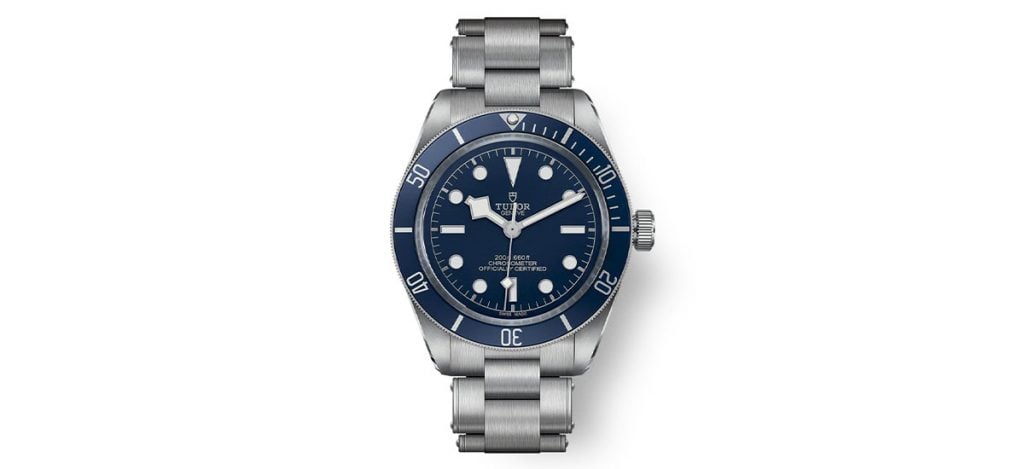
The Black Bay models that have proven to be most popular in the modern chapter of Tudor, bringing back the characteristic Snowflake hands in 2012. This is paired with the aesthetics of the rounded indexes used in the 1958 7294 “Big Crown” Tudor Oyster Prince Submariner, a model that inspired the “big crown” remastered Black Bay and Black Bay 58 with vintage cues like domed sapphires, and faux rivet bracelets.
In 2019, Tudor would surprise lockdown-tired enthusiasts when they released a “blue” Black Bay 58. This would further tie the modern watch with the history of the original Snowflake as it was identical in color to the iconic “Snowflake Blue” of old, with a 39mm case sized similar to that of the vintage Snowflakes; this stands as a worthy modern successor that reminds us of the original.
Tudor Pelagos 42
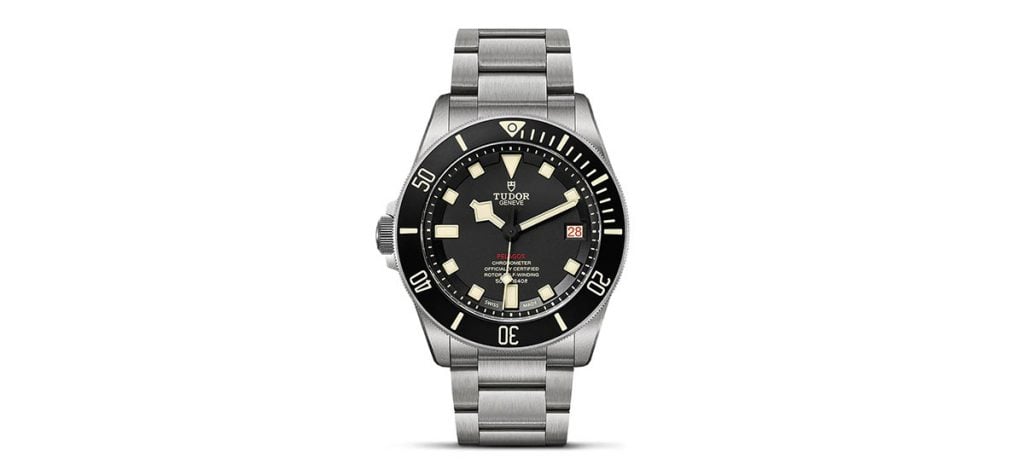
In 2012, Tudor wowed us with the release of the Pelagos 42mm, a modern specification titanium, 500m water resistant, helium escape valve equipped professional dive watch that drew inspiration from vintage Snowflakes, bringing back a full Snowflake dial.
It seemed appropriate that the utilitarian-focused Pelagos 42 would bring back the legible layout created specifically for the needs of the professional diver. Its host of features includes a fully lumed stepped snowflake dial (with a date window at 3 ’o clock), snowflake hands, a fully lumed uni-directional ceramic bezel for ultimate legibility, and a 42mm titanium case with unique pointed crown guards attached to a titanium bracelet with a bracelet extension equipped clasp.
Explore the
Biggest Pre-Owned Collection of Luxury Watches
It comes offered with a black dial and bezel, a bright blue dial and bezel, or as an LHD variant with a black dial and bezel and the return of the unique roulette date wheel seen on vintage Submariner Snowflake 7021s.
Tudor Pelagos 39
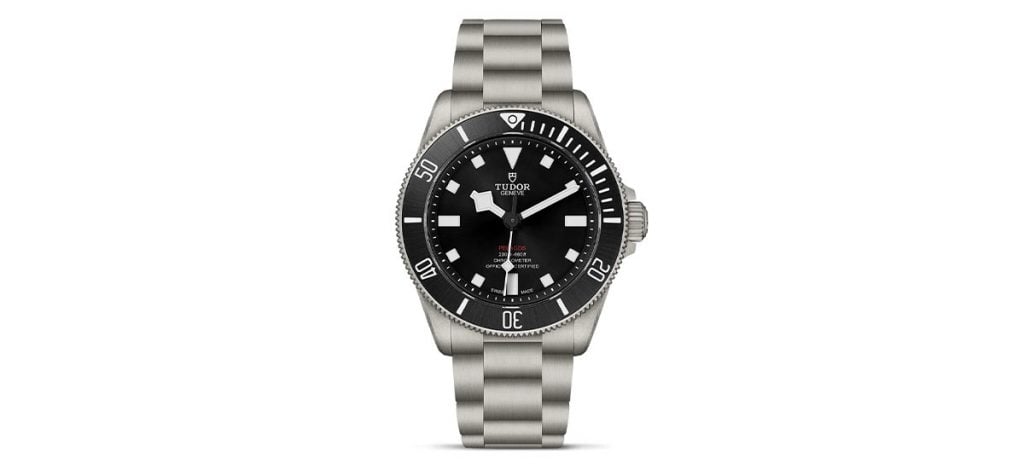
After the release of the Pelagos 42 (42mm) and the consequent release of the Black Bay 58 (39mm), enthusiasts knew that it would be within Tudor’s capability to give us a 39mm (toned down) Pelagos which would share the closest resemblance in sizing and wearability to the original 39mm Snowflakes. In 2022, Tudor finally gave us the modern-day equivalent of the Snowflake that we had all been waiting for.
A Pelagos 39 with a 200m water-resistant titanium crown guard equipped case, attached to a titanium bracelet with a t-fit clasp, sporting a cleanly executed no date sunburst black full Snowflake dial (with red Pelagos text), paired with a sunburst black ceramic full lume unidirectional dive-bezel.
While the materials used in comparison to the original Snowflakes have been modernized through the usage of titanium and ceramic instead of steel and aluminum, its elegant proportions and shared aesthetics offer a familiar experience.
Tudor Pelagos FXD
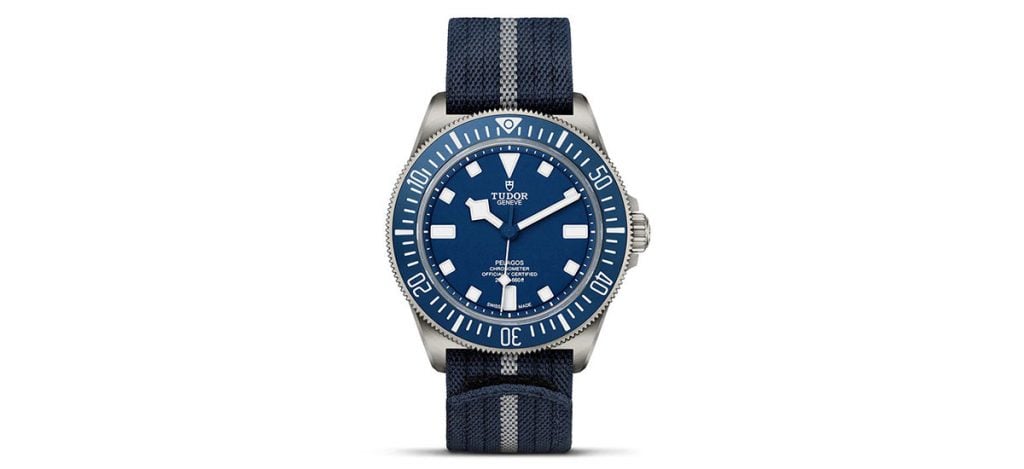
In 2021 Tudor gave us a military specification diver with the release of the Pelagos FXD. The brand would come full circle with its Marine Nationale history, with the new release drawing inspiration from the original Snowflakes through the usage of the highly legible Snowflake dial (originally created with feedback from the Marine Nationale).
Unlike its counterparts that were simply references listed in the catalog supplied to the military, the Pelagos FXD would be specifically designed with their preferences in mind making it the most hardcore and purposeful Snowflake to date.
It would feature a 42mm (200m water resistant) crown guard equipped titanium case with fixed lugs, a fully lumed full snowflake dial in navy blue, a matching navy blue fully graduated and fully lumed ceramic bezel (bi-directional for navigation) with deeper knurling, and would only be offered on a nato and a rubber strap. Like the vintage MN/year stamped caseback Submariners, the FXD would also see the continuation of the engraving offering a unique aspect of collectability to the modern-day collector.
Conclusion
Today, Tudor stands as an independent brand from Rolex with the freedom to draw inspiration from its past while fulfilling the requirements of delivering a modern specification tool watch; it has been celebrated for its value proposition by dive watch enthusiasts of the highest caliber.
The unique history of the original Oyster Prince Submariner Snowflakes made under the same roof as its sister brand Rolex, sharing components like cases, bracelets, winding crowns, and using more affordable movements, has made the Snowflake an icon of its own.
To further strengthen its significance, the Snowflake Submariners had a parallel path to that of the most iconic diver watch ever, with the adaptation of the Snowflake dial that was created through military feedback, making it essentially a version 2 of the characteristic Submariner layout.
In a parallel universe, perhaps Rolex would have loved the Snowflake layout for themselves, as it could be argued to be a more purposeful, legible, and better design. Certainly an icon.
About Exquisite Timepieces
Established in 1998, Exquisite Timepieces is your one-stop shop for all things luxury watches! We are an authorized dealer for 60+ luxury watch brands including Omega, Hublot, Seiko, & Longines! We are proud to showcase one of the world’s largest pre-owned watch collections, including renowned brands like Rolex and Patek Philippe. Check out our brand new watch arrivals here and popular pre-owned listings here.


